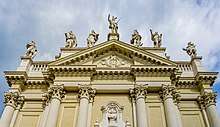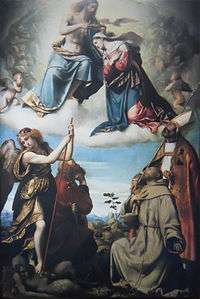Santi Nazaro e Celso, Brescia
The church of Santi Nazaro e Celso is located on Corso Giacomo Matteotti, at the intersection with via Fratelli Bronzetti, in Brescia, Lombardy, Italy. The church contains the Averoldi Polyptych (1522), a masterwork of Titian.
| Santi Nazaro e Celso | |
|---|---|
 Pediment with Christ and six statues of saints | |
| Religion | |
| Affiliation | Roman Catholic |
| Province | Brescia |
| Location | |
| Location | Brescia, Italy |
| Geographic coordinates | |
| Architecture | |
| Type | Neoclassic Facade |
| Groundbreaking | 13th century |
| Completed | 1780 |
History
Originally a church was found at approximately the same site in 1222, in an area that was soon enclosed by enlarged city walls. A major reconstruction began in 1746, by designs of abate Zinelli, and completed in 1781, leading to the statue-topped neoclassical facade we see today.[1] It was interrupted in 1769 by an accidental explosion of a powder magazine at nearby Porta Nazaro. Reconstruction finally ceased and worship was resumed in 1780. Seventeen years later the college of canons was suppressed, but the church remained functioning as a parish church. The organ in the church was completed by Luigi Amati in 1803.
The entrance has a bust of one of the patrons of the reconstruction, the bishop of Modone, Alessandro Fe.[2]
Interior

In addition to the polyptych, the church contains the following artworks:
- Coronation of the Virgin with Saints (circa 1534) by il Moretto, 2nd altar to left.
- Passion of Christ with Moses and Solomon (or David) (1541-1542) by Moretto, 3rd altar to right.
- Annunciation by Gabriello Rottini, 3rd altar to left.
- Adoration of the Shepherds with Saints Nazarius and Celsus (circa 1540) by Moretto, 4th altar to left.
- Madonna and child with St. Laurence and Augustine (c. 1460-1480) by Paolo da Caylina the Elder.
- Polyptych of St Rocco (c. 1590) by Antonio Gandino.
- Adoration of the Magi (1740) by Giambattista Pittoni.
- Death of St. Joseph (1738) by Francesco Polazzo.
- St Barbara and donor (1588) by Lattanzio Gambara.
References
- Guida di Brescia rapporto alle arti ed ai monumenti antichi e moderni, by Federico Odorici (1853), page 101-102.
- F. Odorici, page 102.
External links
| Wikimedia Commons has media related to San Nazzaro e Celso, Brescia. |